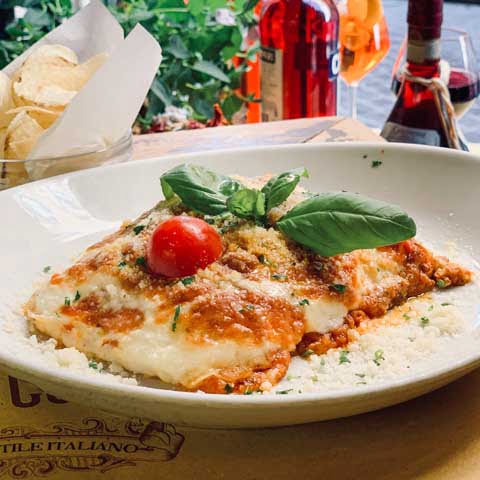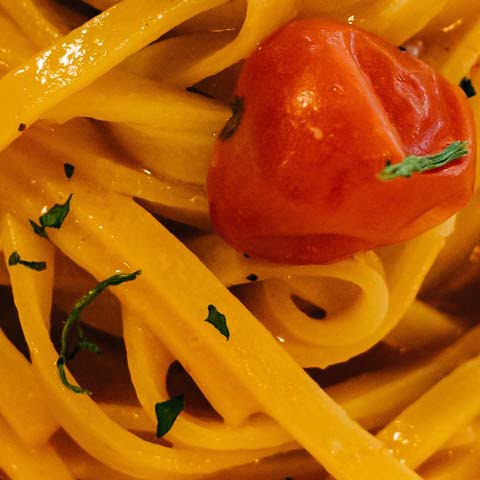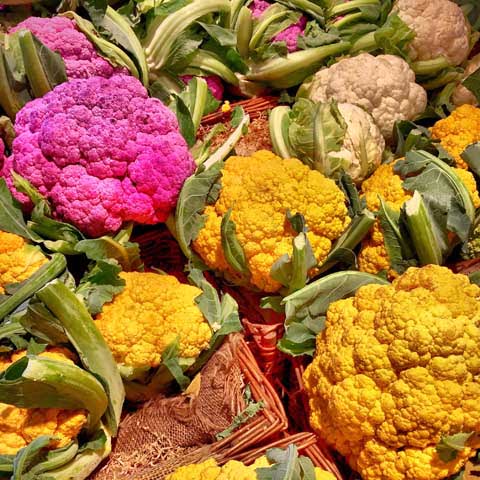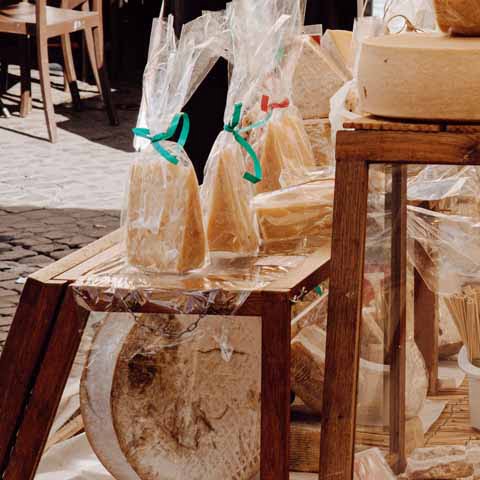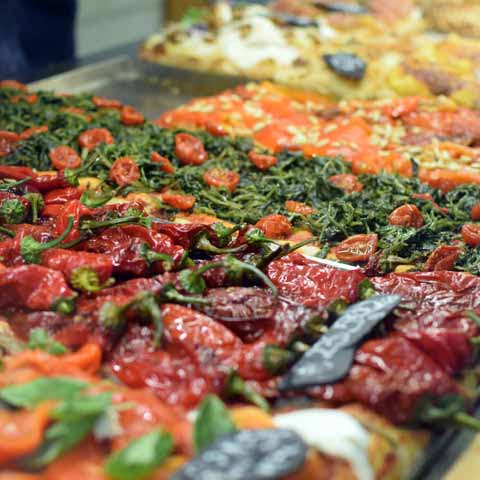Roman cuisine, like the city itself, was formed over many centuries of cultural, political, and societal shifts. Colors of the various cultures that once inhabited the area, such as Romans and Hebrews, are still noticeable throughout the culinary culture of modern day Rome. In addition, the cuisine displays elements of various classes throughout the city’s long history. While wealthy ancient Rome was once a key city of high-cuisine – with the world’s best chefs of the time working for the Popes – peasants made use of scraps and capitalized on every available ingredient. Shades of these high and low-class culinary traditions of Rome’s past can still be experienced today. With star ingredients such as local, fresh vegetables, locally sourced meats, and fresh cheeses, every dish in Rome is rich in both flavor and history. Prepared simply and thoughtfully, Roman food highlights the best of seasonal, fresh ingredients.
APPETIZERS
Opening a meal with an appetizer is a custom that dates to ancient Rome. The tradition is to enjoy gustatio, or a simply prepared finger food, as a way to simply whet the appetite and prepare for the full meal. Also known as antipasto, appetizers can be as simple as a platter of cured meats such as ham or prosciutto accompanied by dried cheese such as pecorino. A few key appetizers are prevalent throughout Rome.
Fave e pecorino, a dish comprised of small cuts of pecorino cheese and fava beans, is a traditional Roman appetizer that meets the qualifications of being simple and easy to eat. Usually served with bread and red wine, this dish is known to quickly become the main meal, as diners typically enjoy it so much they eat until they’re full.
Crostini, a popular appetizer throughout Italy, is also key in Rome. However, the Roman version is a bit different. Panzanella Romana is a type of crostini where the bread is soaked quickly in water and then rubbed with half a tomato, soaking up the tomato’s juice. Olive oil is drizzled on top, followed by salt and fresh leaves of basil. Simple, yet delicious, this appetizer captures the essence of Roman gustatio.
As vegetables are a mainstay throughout Roman cuisine, they often appear in the appetizer course as a key ingredient. Zucchini flowers dipped in batter are deep fried to create a dish that is crispy and crunchy on the outside yet soft and juicy on the inside. Artichokes, a very popular ingredient in Roman cooking, are also fried or braised to create unique starters. Romanesco artichokes, which are large and round, are the most common choice, because they are free of thorns and very tender.
From figs wrapped in prosciutto to platters of fresh vegetables to dip in olive oil, appetizers in Rome are sure to whet the appetite and give diners a tease of courses to come.
FIRST COURSE
Throughout Italy, first courses typically consist of pasta or rice. Rome is no different. Characterized by pastas that are full of flavor, first courses in Rome tend to be rich pasta dishes that are popular in Italy and all over the world.
Amatriciana is a main culinary symbol of Rome and a traditional first dish in the city. Made with long pasta such as bucatini, this dish is made with browned guanciale (pork jowls), tomato sauce, and a generous amount of fresh grated pecorino cheese. Another popular first course pasta dish is pasta alla gricia. This dish is made with the same ingredients as amatriciana, however it utilizes rigatoni and does not call for tomato sauce. It can be found in most family-owned trattoria throughout Rome.
A well-known and loved dish around the world, carbonara is a renowned dish in the Roman culture. Made simply with eggs, black pepper, guanciale, pecorino, and a long pasta such as linguine, spaghetti, or bucatini, this dish is rich, savory, and flavorful. In Rome, the dish is made with seasoned and cured pork jowls as opposed to pancetta (bacon) that is commonly used throughout the world. The intense flavor of the guanciale and pecorino help to make it delectable and quite addicting.
A unique pasta that can only be found in local Roman trattorias is rigatoni con la pajata. It is crafted from rigatoni pasta and the intestines of unweaned calves – ones that have exclusively been fed their mother’s milk. After being cleaned and cooked, the intestines create a thick sauce that is almost cheese-like. The dish is a truly one-of-a-kind Roman experience.
For the simplest of dishes, Romans often enjoy first courses of ajo e ojo – boiled pasta tossed with minced garlic and olive oil – or cacio e pepe – cooked pasta served only with pecorino cheese and black pepper.
Roman first courses are always extremely flavorful and display the Romans appreciation of whole, fresh, local ingredients.
SECOND COURSE
Keeping in tune with the traditional Italian meal structure, second courses in Rome typically feature meat or fish as the primary ingredient. Game such as oxtail and lamb are popular, as well as fish, cured meats, and in honor of the peasant cultural traditions of the city, offal – the parts of the animal such as organs that would otherwise be thrown out.
An example of offal as a feature ingredient is the classic Roman dish trippa alla romana, or Roman-style tripe. To make the dish, tripe (cow stomach) is sautéed in olive oil with garlic and onion. Once cooked, it is covered with a flavorful tomato sauce and stewed. Before serving, it is sprinkled with a hard cheese such as pecorino or parmigiano. The bitterness of the tomato sauce offsets the richness of the tripe, creating a perfectly balanced and delicious dish.
For those looking to enjoy a less adventurous protein in their meal, dishes such as abbacchio – roasted milk-fed lamb, coda alla vaccinara – a famous oxtail stew braised with tomatoes, celery, herbs, and other vegetables – and saltimbocca alla romana – veal wrapped in prosciutto and sage then marinated with wine or salted water – are great representations of traditional Roman second courses.
SIDES
Alongside some of the first and second course offerings in Rome, one should expect to find a variety of vegetables cooked in many ways. Some of the most popular offerings are fava beans, peas, and artichokes – a main staple throughout Rome. A traditional preparation of artichokes that is a very common throughout the city is carciofo alla giuda – a cherished Roman Jewish recipe. In this dish, the artichoke is deep fried in hot olive oil until tender.
DESSERTS
After a long day of touring Rome’s many fascinating locales, consider enjoying a few of the city’s unique desserts. One of the most popular is maritozzi. This traditional wedding dessert is a rich pastry that is cut in half and filled with flavorful whipped cream. While in the Hebraic quarter of Rome, dig into crostata di ricotta (ricotta pie). A common snack of the Roman-Jewish tradition, the pie is made from flaky crust, ricotta cheese, eggs, sugar, and can sometimes be layered with fruit jams. For a very traditional and simple sweet snack, delight in ciambelle al vino. These Italian wine biscuits are dusted with powdered sugar and are a common Christmas dessert throughout Rome.
STREET FOODS
While Romans pride themselves on enjoying the moment at mealtime, they too have their own version of fast food. Street foods, often sold from carts or small windows off the street, are a quick way to enjoy traditional Roman flavors.
As with all of Italy, pizza is a common street food in Rome. Pizzerias sell on-the-go slices of different varieties of pizza, including pizza Romana, known for its dough which creates a thin crust and crunchy texture.
Fried foods are also common street treats. Supplì (fried rice and mozzarella balls), filetti di baccala (fried salt cod filets), fiori di zucchini alla Romana (fried zucchini blossoms with mozzarella and anchovies) are all iconic street foods throughout Rome.
The king of Roman street food, however, is porchetta. A dish of roasted, boneless pork, it is the most common snack for locals during afternoon or late night hours. Often served with a side of vegetables or as a filling for a panini, porchetta is a must-try when in Rome.
WINES
One cannot travel to any city in Italy without tasting some of the region’s best wines. Rome’s surrounding wine production areas offer a wide variety of delicious wines, the best of which are mostly white wines and a few reds. Standout white wines include Cannellino di Frascati, Frascati Superiore, Colli Albani Superiore, and Zagarolo – all well-loved for their freshness and easy drinkability. As for red wines, Castelli Romani is a delightful, fruity, light red that is a local favorite.
With a glass of local wine in hand, one can truly immerse themselves in the Roman food culture to taste the city’s long history and rich culture.
Travel Guides
The Lazio Region of Italy
Cities of Lazio
